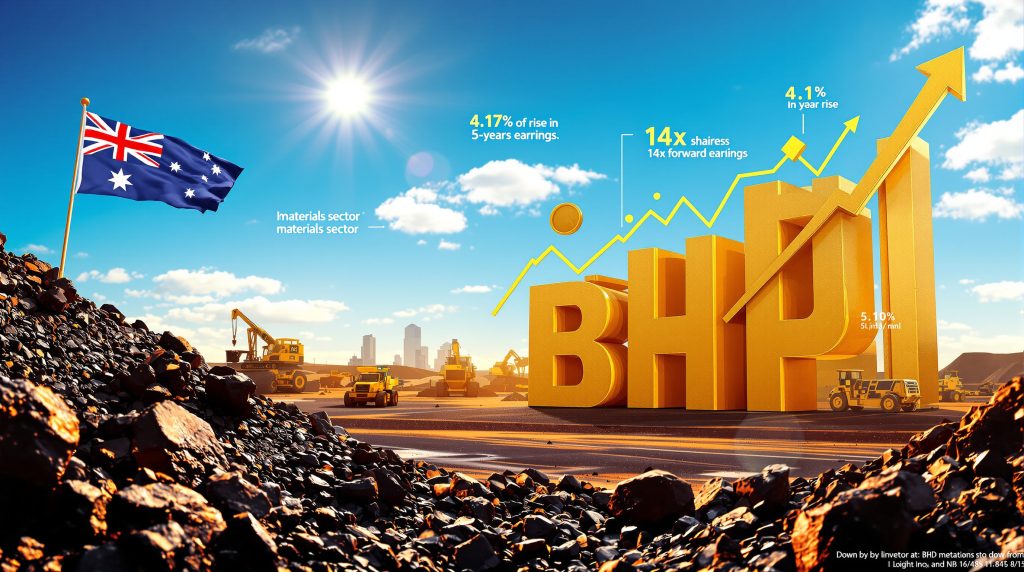Understanding BHP's Market Position in 2025
BHP shares are currently commanding significant investor attention, trading at approximately 14 times forward earnings as of August 2025. This valuation represents the highest level the mining giant has reached since January 2021 and notably sits above its five-year average valuation metrics. With the company's full-year results announcement scheduled for August 19, 2025, market participants are closely monitoring whether these premium valuations will be justified by the upcoming financial disclosures.
The mining behemoth's strong market position comes amid changing investor sentiment across Australian equities. BHP's robust valuation reflects not only company-specific strengths but also broader sector-wide trends that have been developing throughout 2025. These premium multiples have persisted despite traditional concerns about cyclicality in the mining sector, suggesting a potential structural shift in how investors are approaching resource stocks.
Financial analysts point to several factors supporting these elevated valuations, including BHP's operational efficiency improvements, strategic portfolio management, and disciplined capital allocation approach. The company's ability to maintain strong margins even during commodity price fluctuations has impressed market watchers and contributed to investor confidence in its long-term prospects.
BHP's balance sheet strength has also played a crucial role in justifying its premium valuation. With relatively low debt levels compared to historical norms and substantial cash reserves, the company has positioned itself to weather potential economic headwinds while maintaining flexibility for strategic investments and shareholder returns.
What's Driving the "Great Rotation" from Banks to Miners?
Shift in Investor Sentiment
A significant realignment of capital allocation preferences has been underway in Australian markets, with what market analysts are calling a "great rotation" from banking stocks to mining shares. This notable shift began in June 2025 and has gained momentum through mid-2025, transforming sector performance patterns across the ASX.
The materials sector emerged as a clear beneficiary, rising an impressive 4.1% in July 2025 alone. This performance represents the best monthly showing for miners since September 2024, highlighting the strength and persistence of this rotation. During the same period, financial shares moved in the opposite direction, dropping approximately 1% and significantly underperforming the benchmark S&P/ASX 200 Index.
Tony Sycamore, market analyst at IG Australia, has characterized this movement as a fundamental repositioning, noting: "We've seen a great rotation out of banks and into miners since June, and we expect this reshuffle to continue." This expert assessment suggests the trend has staying power rather than representing a temporary market anomaly.
The rotation appears particularly striking given the traditional investor preference for banking stocks during periods of economic uncertainty. Banks had previously benefited from defensive positioning strategies as investors sought stability amid concerns about global economic conditions.
Macroeconomic Factors Influencing the Shift
Several macroeconomic developments have converged to catalyze this sector rotation. For years, mining stocks struggled under the weight of China's economic slowdown, which dampened demand for key commodities and pressured profit margins across the sector. However, recent policy shifts in China aimed at stabilizing growth have created a more supportive environment for resource companies.
Simultaneously, changing interest rate expectations have altered the relative attractiveness of banking stocks. With central banks signaling a potential shift in monetary policy trajectories, investors have reassessed their exposure to interest-rate-sensitive sectors like financials.
Commodity price dynamics have also played a crucial role in driving this rotation. Iron ore trends have demonstrated remarkable resilience despite previous concerns about oversupply, while copper and other industrial metals have benefited from increasing demand tied to energy transition technologies. These favorable price trends have boosted confidence in miners' earnings potential.
Global supply constraints have further supported the case for mining investments. Production limitations in key mining regions, combined with years of underinvestment in new capacity, have created a tighter supply environment that supports higher commodity prices and improved profit margins for established producers like BHP.
The rotation also reflects evolving investor priorities regarding environmental, social, and governance (ESG) considerations. Many mining companies have made substantial progress in addressing historical ESG concerns, improving their appeal to institutional investors with sustainability mandates.
How Does BHP Compare to Other Mining Giants?
BHP's Market Position
As the world's largest mining company by market capitalization, BHP occupies a unique position within the global resources sector. The company's primary focus remains on iron ore, which continues to generate substantial cash flows despite price volatility. However, BHP's portfolio diversification across copper, coal, nickel, and potash provides important revenue streams beyond its core iron ore business.
BHP's geographic footprint centers on its massive operations in Western Australia, which benefit from world-class ore quality and well-developed infrastructure networks. These Australian assets are complemented by significant international operations, giving the company global scale advantages that few competitors can match.
The company's competitive advantages extend beyond mere size. BHP has consistently demonstrated superior operational efficiency, maintaining lower production costs compared to many competitors. This cost leadership position provides valuable margin protection during commodity price downturns while amplifying profitability during favorable price environments.
BHP's technological leadership has further strengthened its market position. The company has invested heavily in automation, data analytics, and remote operations capabilities, improving both safety outcomes and operational performance. These mining tech advancements contribute to BHP's ability to extract maximum value from its resource base.
Peer Comparison
When examining valuation metrics across the mining sector, BHP's current price-to-earnings ratio of approximately 14x represents a premium compared to several major competitors. This valuation differential reflects market confidence in BHP's management execution and growth prospects relative to peers.
In terms of share price movement, BHP has outperformed most other major Australian miners over the past 12 months, though specific comparison points vary by sub-sector. This outperformance signals stronger investor confidence in BHP's strategic direction and operational capabilities compared to alternatives within the sector.
Dividend yields represent another important dimension of comparison. BHP has maintained an attractive dividend policy, with yields competitive with other major miners despite its premium valuation. This combination of growth potential and income generation has broadened BHP's appeal to different investor segments.
Growth prospects vary significantly across major mining companies. BHP's future expansion projects, particularly in copper and potash, offer promising production growth trajectories. The company's development pipeline compares favorably to peers who face more significant resource replacement challenges or operational constraints.
Management quality assessments frequently place BHP among the industry leaders. The company's executive team has demonstrated disciplined capital allocation, avoiding the value-destructive acquisition sprees that have plagued competitors during previous commodity boom cycles.
What Are the Investment Implications for Mining Stocks?
Outlook for Australian Mining Sector
Expert forecasts broadly support the continuation of the sector rotation trend, with several analysts projecting further outperformance for materials stocks through the remainder of 2025. Technical indicators also suggest maintained momentum, with many mining stocks exhibiting strong chart patterns and favorable volume trends.
Despite the positive outlook, investors should remain mindful of potential headwinds. Chinese property sector challenges continue to pose risks to commodity demand, while global recession concerns could temporarily impact industrial activity and materials consumption.
Commodity price influences remain paramount when assessing mining stock valuations. Current market dynamics suggest continued strength for copper price insights and specialty metals tied to energy transition applications, while bulk commodities like iron ore face more balanced supply-demand conditions.
The Australian mining sector's outlook is further shaped by currency considerations. The Australian dollar's movements relative to the US dollar significantly impact the earnings translation for export-focused miners, adding another variable for investors to monitor.
Regulatory developments also warrant attention, particularly regarding carbon emissions policies and environmental compliance requirements. The sector faces evolving standards that could affect operational costs and development timelines for new projects.
Strategic Considerations for Investors
Portfolio allocation strategies should carefully weigh optimal exposure levels to mining versus banking sectors. While the rotation trend supports increased materials weightings, prudent investors will maintain diversification rather than making extreme sector bets.
Timing considerations suggest watching for key market signals that might indicate either continuation or exhaustion of the current rotation. Economic data releases from China, central bank policy announcements, and commodity inventory reports provide important inflection point indicators.
Diversification approaches within the mining space deserve particular attention. Different commodities face distinct supply-demand dynamics, suggesting potential benefits to spreading investments across various mining subsectors rather than concentrating solely in iron ore producers.
"Investors should consider not just the headline valuation metrics but also the underlying commodity price assumptions baked into current share prices," notes a prominent Australian investment strategist. "The sustainability of premium valuations depends heavily on whether commodity price forecasts materialize."
Long-term versus short-term positioning considerations vary by investor profile. While tactical traders might focus on capturing the current rotation momentum, long-term investors should evaluate whether structural factors support sustained mining sector outperformance beyond the current cycle.
- Tactical positioning might include overweighting miners showing the strongest operational momentum
- Strategic allocations should consider commodity diversification and balance sheet strength
- Income-focused investors should evaluate dividend sustainability across different price scenarios
- ESG-conscious investors should assess miners' progress on sustainability metrics and climate targets
How Might BHP's Upcoming Results Impact Valuations?
Key Metrics to Watch
BHP's upcoming results announcement on August 19, 2025, will provide critical insights into whether current premium valuations are justified. Production volumes across major commodity segments will be closely scrutinized, with particular attention to iron ore output and any signs of operational disruptions.
Cost management metrics will be equally important given inflationary pressures across the mining industry. Investors will focus on BHP's ability to maintain cost discipline while navigating higher input prices, labor constraints, and energy costs. Any deterioration in unit cost performance could raise concerns about margin sustainability.
Capital allocation decisions will provide important signals about management's confidence in the business outlook. The balance between growth investments, debt reduction, and shareholder returns through dividends and buybacks will influence market perceptions of BHP's long-term strategy.
Forward guidance for fiscal year 2026 may prove even more significant than the historical results themselves. Management commentary on production targets, cost trajectories, and capital expenditure plans will shape analyst forecasts and valuation models going forward.
Sustainability performance metrics have gained increasing importance in investor assessments. BHP's progress toward emissions reduction targets, water management improvements, and community engagement outcomes will factor into ESG-focused investment decisions.
Potential Market Reactions
Upside scenarios that could drive further valuation expansion include better-than-expected production numbers, cost performance exceeding guidance, larger-than-anticipated shareholder returns, and positive commentary on demand conditions across key markets.
Downside risks that might trigger corrections include production disappointments, cost inflation exceeding management expectations, capital expenditure increases without clear return profiles, or cautious guidance regarding commodity market conditions.
Analyst consensus currently anticipates solid operational performance with moderate production growth and stable cost structures. Earnings projections incorporate relatively conservative commodity price assumptions, potentially providing upside surprise potential if prices remain elevated.
Technical support and resistance levels suggest BHP shares would find initial support around previous consolidation zones if results disappoint, while upside breakouts could accelerate if strong results trigger positive analyst revisions.
Disclaimer: This analysis contains forward-looking statements based on current market conditions and expectations. Actual results may vary significantly based on unforeseen developments in commodity markets, operational performance, or macroeconomic conditions. Investors should conduct their own research and consider their individual circumstances before making investment decisions.
FAQ: BHP Valuation and Mining Sector Rotation
Why are investors rotating from banks to miners in 2025?
The rotation from banking to mining stocks in 2025 reflects several converging factors. Changing economic conditions have created a more favorable environment for cyclical stocks like miners, which typically outperform during periods of economic recovery and moderate inflation.
Shifting commodity demand patterns have surprised many market observers, with resilient consumption despite previous concerns about Chinese economic slowdown. Infrastructure investments and energy transition projects have supported demand for key industrial metals.
Relative valuation attractiveness has emerged after a prolonged period of mining sector underperformance. Prior to the rotation, many mining stocks traded at historically low multiples compared to their banking counterparts, creating a compelling value proposition for investors seeking sector rebalancing opportunities.
Geopolitical factors have also influenced this rotation, with resource security concerns elevating the strategic importance of mining companies that control critical mineral assets. This dimension has attracted increased investor attention to companies with exposure to battery metals and other strategically important commodities.
Is BHP's current valuation sustainable?
Historical precedents suggest premium valuations for high-quality mining companies can persist for extended periods during favorable commodity cycles. Previous episodes of sustained above-average multiples occurred during 2003-2007 and 2010-2012, periods characterized by strong commodity prices and positive sentiment toward resources.
Factors that could support current multiples include disciplined industry-wide capital allocation, limited new supply development, and structural demand growth for transition metals. Unlike previous cycles, major miners have demonstrated restraint in expanding production capacity, potentially extending the favorable pricing environment.
Challenges to current valuations could emerge from several sources, including faster-than-expected Chinese economic deceleration, aggressive production expansions by competitors, or macroeconomic developments that trigger broad market corrections.
Comparison to long-term average valuations indicates BHP currently trades at a significant premium to its 10-year median multiple. However, company-specific improvements in portfolio quality, balance sheet strength, and operational efficiency provide some justification for a higher baseline valuation compared to historical norms.
How does China's economic situation impact Australian miners?
China remains the dominant influence on commodity markets despite diversification efforts, accounting for approximately 70% of seaborne iron ore demand and significant portions of copper, coal, and other key commodity consumption. Chinese property sector challenges have raised concerns about construction-related materials demand, though infrastructure spending has provided offsetting support.
Recent policy changes affecting resource imports have created both challenges and opportunities for Australian miners. While certain commodities have faced import restrictions or tariffs, others have benefited from China's strategic stockpiling initiatives and energy transition priorities.
Alternative markets have emerged to partially offset Chinese demand fluctuations. India's growing infrastructure needs, Southeast Asian industrialization, and developed market reconstruction projects have created more diversified demand sources for major commodities, reducing miners' exclusive dependence on Chinese consumption.
Supply-side responses within China itself significantly impact Australian miners' prospects. Chinese domestic production decisions for commodities like coal and iron ore influence import requirements and global price formation. Environmental and safety regulations affecting Chinese producers can create opportunities for Australian exporters offering higher-quality, more sustainable products.
What other Australian mining stocks are benefiting from the rotation?
Performance metrics across the Australian mining sector show broad-based benefits from the investor rotation, though with significant variation by subsector. Diversified miners with strong balance sheets have generally outperformed more specialized operators, though exceptional cases exist in high-demand specialty minerals.
Relative valuation comparisons reveal interesting patterns across the sector. While most mining stocks have experienced multiple expansion during the rotation, the degree of revaluation varies considerably based on commodity exposure, operational track record, and growth prospects.
Specialized miners focused on energy transition minerals have attracted particularly strong investor interest. Companies with exposure to copper, nickel, lithium, and rare earth elements have benefited from both the general mining sector rotation and specific demand growth tied to electrification and renewable energy deployment.
Emerging producers and development-stage companies have seen renewed investor interest after years of funding challenges. The improved sentiment toward mining has opened financing opportunities for earlier-stage projects, though with continued emphasis on jurisdictional risk, environmental permitting, and technical feasibility.
Navigating the Mining Investment Landscape
The current premium valuations for BHP and other major mining companies reflect a complex interplay of macroeconomic factors, sector-specific developments, and changing investor preferences. While the "great rotation" from banks to miners has created significant momentum for resources stocks, investors should carefully evaluate the sustainability of current trends.
Commodity price assumptions remain the fundamental driver of mining stock valuations, requiring careful assessment of supply-demand balances across different materials. The divergent outlooks for various commodities highlight the importance of understanding the specific exposure profiles of different mining companies.
Portfolio construction should balance the potential for continued mining sector outperformance against diversification principles and individual risk tolerance. The cyclical nature of resource stocks suggests maintaining some exposure to more defensive sectors even within a pro-mining investment thesis.
Risk management deserves particular attention given the premium valuations currently observed. Investors should consider position sizing, stop-loss strategies, and hedging approaches to protect against potential reversals in sector sentiment or commodity prices.
Long-term structural trends still favor significant mining industry innovation to support global energy transition goals, infrastructure development, and industrial production. These fundamental drivers provide a solid foundation for the sector beyond short-term rotation dynamics.
According to Mining.com, the current BHP share price valuation represents a significant premium compared to historical averages, reflecting investor confidence in the company's strategic positioning. Furthermore, analysis from The Bull suggests that Australian mining stocks remain attractive within a global context, particularly those with strong operational track records and exposure to future-facing commodities.
For investors considering both short and long-term horizons, understanding the interplay between cyclical factors and structural mining market perspectives will be crucial for navigating this dynamic sector successfully.
Disclaimer: Commodity markets and mining stocks involve significant risks including price volatility, operational challenges, and regulatory uncertainties. Past performance is not indicative of future results. Investors should seek professional advice tailored to their specific circumstances before making investment decisions.
Ready to Spot the Next Major Mining Discovery?
Stay ahead of the market with Discovery Alert's proprietary Discovery IQ model, delivering real-time notifications when significant mineral discoveries are announced on the ASX. Visit our discoveries page to see how historic discoveries have generated substantial returns and start your 30-day free trial today.




